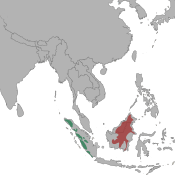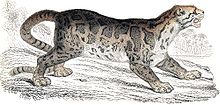Sunda Clouded Leopard
| Sunda Clouded Leopard | ||||||||||||
|---|---|---|---|---|---|---|---|---|---|---|---|---|

Sunda Clouded Leopard ( Neofelis diardi ) |
||||||||||||
| Systematics | ||||||||||||
|
||||||||||||
| Scientific name | ||||||||||||
| Neofelis diardi | ||||||||||||
| ( Cuvier , 1823) |
The Sunda clouded leopard ( Neofelis diardi ) is a species of cat found in Borneo and Sumatra that was classified as a species different from Neofelis nebulosa in 2006 .
Since 2008, the Sunda clouded leopard is on the Red List of Threatened Species as endangered ( vulnerable out).
In 2009, the biologists Mohamed and Wilting recorded the first footage of a Sunda Clouded Leopard in the Demarkot Forest Reserve in Sarawak , Malaysia .
features
The Sunda clouded leopard reaches a head-trunk length of 70 to 105 cm, a tail length of 60 to 85 cm and a weight of 10 to 25 kg. The males are generally larger than the females. The Sunda clouded leopard has longer canine teeth and thicker fangs in the upper jaw than the clouded leopard. The cloud drawings of the Sunda clouded leopard fur are smaller and darker and there are many noticeable spots within the cloud spots. The fur is grayer, generally darker, and it has a dark, continuous, double eel line.
distribution and habitat
Sunda clouded leopards are likely only found in Borneo and Sumatra . On Borneo, they live mainly in the rainforest below 1,500 meters above sea level and, to a lesser extent, in cleared forest. In Sumatra, they are apparently more numerous in hilly, mountainous regions. It is not known whether they will survive on the Batu Islands near Sumatra.
They use trees as resting places above the ground, as well as to escape land leeches and hide their prey or parts of it.
Between March and August 2005, the population of Sunda clouded leopards in the Tabin Game Reserve in Sabah was surveyed. The analysis of their different traces shows that there are five individuals living in the 56 km 2 area of the study at an estimated density of eight to 17 individuals per 100 km 2 . Roughly estimated, the population in Sabah is around 1,500–3,200 Sunda Clouded Leopards, of which only 275–585 live in fully protected areas that are large enough for a long-term survivable population of more than 50 individuals.
In 2008, only two Sunda clouded leopards were detected by camera traps in an area of 112 km 2 in a commercial forest area in northeast Sabah in seven months . The density of the population in forests with logging is much lower than in protected areas. Little is known about the habitat requirements of the Sunda clouded leopards.
Sumatra is likely to have only 1.29 Sunda clouded leopards per 100 km 2 . The significantly lower density compared to Borneo is explained by the fact that they live sympatric with tigers , while in Borneo they are the largest cats.
Way of life
The Sunda clouded leopard is predominantly nocturnal, but it can also be seen during the day in Borneo, where other large predators are lacking. Like other cats, the Sunda Clouded Leopard is likely a loner. Outside the mating season, the only longer-term connection between the females and their young is. The long, thick tail of the Sunda clouded leopard as well as the large paws and short legs suggest that it is very well adapted to a tree-dwelling way of life, but the majority of the sightings on Borneo showed that the clouded leopards were predominantly on stopped the ground.
Reproduction
Reproductive data are only available for animals in human care. The gestation period varies between 85 and 109 days, on average it is between 86 and 93 days. The female gives birth to one to five cubs, but the most common are litters of two to three cubs. The boys eat solid food after seven to ten weeks. They are suckled for eleven to 14 weeks. The Sunda Clouded Leopard reaches sexual maturity after 20 to 30 months.
food
The diet consists of a variety of vertebrates, including young sambar deer , muntjacs , stag piglets , orangutans , panty langurs , bearded pigs , musangs , porcupines , fish and birds.
Species protection
The Sunda clouded leopard is listed in Annex I of the Washington Convention and is one of the fully protected species in Sumatra, Kalimantan , Sabah , Sarawak and Brunei .
In November 2006, the Bornean Wild Cat and Clouded Leopard Project was initiated in the protected areas of the Danum Valley Nature Reserve and Tabin Game Reserve , as part of which research is carried out on the ecology and behavior of the five cat species that occur in Borneo - in addition to the Sunda clouded leopard and the Borneo golden cat , Flat head cat , marble cat and bengal cat . In particular, the effects of changes in location are examined, but also the threat to cats from hunting and trade.
In July 2008, the Conservation of Carnivores in Sabah project was initiated in north-east Borneo, which investigates how different strategies of commercial use of three forest areas affect the cats native to them. The aim of the project is to develop a concept for ecologically and economically sustainable nature conservation measures.
Evolutionary and Taxonomic History
Genetic analysis of specimens of Neofelis nebulosa and Neofelis diardi shows that the two species separated about 1.4 million years ago after reaching Borneo and Sumatra from mainland Asia via a now flooded land bridge .
The division of Neofelis diardi into two subspecies roughly coincides with the eruption of the Toba super volcano in Sumatra about 75,000 years ago. It is possible that in the Pleistocene the Sunda clouded leopard resettled Sumatra from Borneo and was later separated by rising sea levels.
The French zoologist Georges Cuvier named the species in his first description from 1823 to the naturalist Pierre-Médard Diard in honor of Felis Diardi . Cuvier described the species on the basis of a drawing and a fur that supposedly came from Java .
For a long time the Sunda clouded leopard was considered a subspecies of Neofelis nebulosa and was called Neofelis nebulosa diardi . In two articles that appeared in December 2006, the two species were reclassified and redefined. Neofelis nebulosa is the name of the species native to mainland Asia, while Neofelis diardi is the species native to the Malay Archipelago .
In 2008, studies of DNA , fur patterns and the morphology of skulls, jaws and teeth showed that the Sunda clouded leopard and clouded leopard differ to the same extent as the panthera species.
Individual evidence
- ^ A b c Valerie A. Buckley-Beason, Warren E. Johnson, William G. Nash, Roscoe Stanyon, Joan C. Menninger, Carlos A. Driscoll, JoGayle Howard, Mitch Bush, John E. Page, Melody E. Roelke, Gary Stone, Paolo P. Martelli, Ci Wen, Lin Ling, Ratna K. Duraisingam, Phan V. Lam & Stephen J. O'Brien: Molecular Evidence for Species-Level Distinctions in Clouded Leopards. In: Current Biology , No. 16, December 5, 2006, pp. 2371-2376.
- ↑ a b Kitchener, AC, Beaumont, MA, Richardson, D. (2006) "Geographical Variation in the Clouded Leopard, Neofelis nebulosa, Reveals Two Species". Current Biology 16 (23): 2377-2383.
- ↑ a b c Hearn, A., Sanderson, J., Ross, J., Wilting, A., Sunarto, S. (2008) Neofelis diardi. In: IUCN 2008. IUCN Red List of Threatened Species.
- ↑ Mohamed, A., Wilting, A. (2009) A clouded leopard filmed for first time in Malaysia Conservation of Carnivores in Sabah
- ↑ Rabinowitz AR, Andau P., Chai PPK (1987) The Clouded leopard in Malaysian Borneo . Oryx 21: 107-111
- ^ Wilting, A., Fischer, F., Bakar, SA, Linsenmair, KE (2006): Clouded leopards, the secretive top-carnivore of South-East Asian rainforests: their distribution, status and conservation needs in Sabah, Malaysia . BMC Ecology 6: 16th PMC 1654139 (free full text)
- ↑ Mohamed, A., Samejima, H., Wilting, A. (2009) Records of five Bornean cat species from Deramakot Forest Reserve in Sabah, Malaysia (PDF; 264 kB) CATnews 51 Autumn 2009
- ↑ Hutujulu, B., Sunarto, Klenzendorf, S., Supriatna, J., Budiman, A., Yahya, A. (2007) Study on the ecological characteristics of clouded leopard in Riau, Sumatra. In: J. Hughes and M. Mercer (Eds.) Felid Biology and Conservation: Program and Abstracts: An International Conference, September 17-20, 2007, Oxford. Oxford University, Wildlife Conservation Research Unit
- ^ Hearn, A., Ross, J. (2006) "Bornean Wild Cat and Clouded Leopard Project". (PDF; 443 kB) Cat Project of the Month - November 2006. IUCN / SSC Cat Specialist Group
- ↑ Wilting, A., Mohamed, A. (2009) Consequences of different forest management strategies for felids in Sabah, Malaysia. (PDF; 478 kB) Cat Project of the Month - May 2009. IUCN / SSC Cat Specialist Group
- ^ Wilting A., Christiansen P., Kitchener AC, Kemp YJM, Ambu L., Fickel, J. (2010) “Geographical variation in and evolutionary history of the Sunda clouded leopard (Neofelis diardi) (Mammalia: Carnivora: Felidae) with the description of a new subspecies from Borneo ". Molecular Phylogenetics and Evolution (in press).
- ↑ Cuvier, G. (1823) Recherches sur les ossemens fossiles; ou, l'on retablit les caracteres de plusiers animaux dont les revolutions du globe ont detruit les especes. Volume IV: Les Ruminans et les Carnassiers Fossiles. Paris: G. Dufour & E. d'Ocagne. Page 437
- ↑ Per Christiansen (2008) Species distinction and evolutionary differences in the clouded leopard (Neofelis nebulosa) and Diard's clouded leopard. In: Journal of Mammalogy Volume 89 , Issue 6, pp. 1435-1446.
literature
- Christiansen, Per: Species distinction and evolutionary differences in the clouded leopard (Neofelis nebulosa) and Diard's clouded leopard . In: Journal of Mammalogy December 2008: Vol. 89 , Issue 6, pp. 1435-1446.
- Kitchener, A. et al. (December 5, 2006): Geographical Variation in the Clouded Leopard, Neofelis nebulosa, Reveals Two Species . In: Current Biology 16 (23) , pp. 2377-2383.
- Sunquist, ME & FC: Family Felidae (Cats) In: Don E. Wilson & Russel Mittermeier (Eds.) Handbook of the Mammals of the World Volume 1: Carnivores . Lynx Edicions. 2009. p. 127. ISBN 978-84-96553-49-1
Web links
- Species profile Sunda clouded leopard; IUCN / SSC Cat Specialist Group in English
- Bornean Clouded Leopard Programs
- Clouded Leopard Conservation and Research in Borneo
- Neofelis diardi in the endangered Red List species the IUCN 2009. Posted by: Hearn, A. Sanderson, J., Ross, J., Wilting, A., Sunarto, p., 2008
- ARKive - Pictures and information on the Sunda Clouded Leopard
- Science Daily, March 15, 2007: New Species Declared: Clouded Leopard On Borneo And Sumatra

